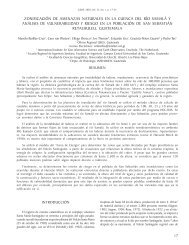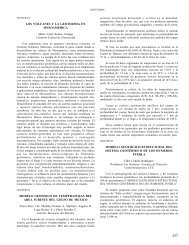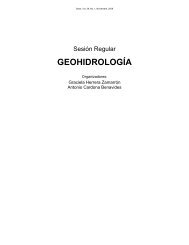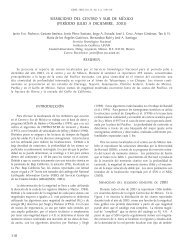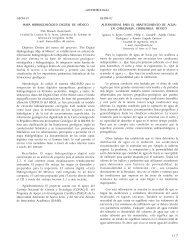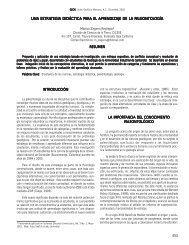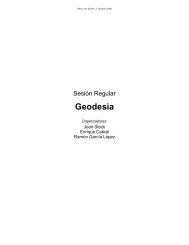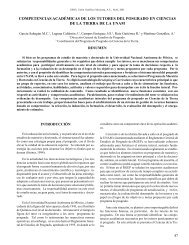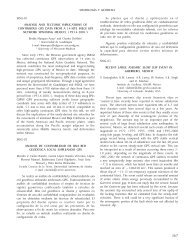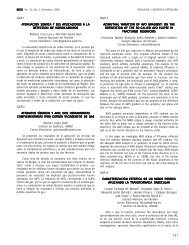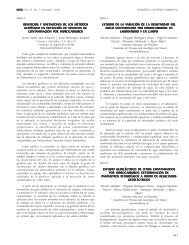SISMOLOGÍA Geos, Vol. 27, No. 1, Octubre, 2007SIS-17ROTATING PROJECTION ALGORITHM ANDAPPLICATION FOR SEISMIC TOMOGRAPHYGrebennikov Alexan<strong>de</strong>r y Valencia Pérez TomásFacultad <strong>de</strong> Ciencias Físico Matemáticas,Benemérita Universidad Autónoma <strong>de</strong> Pueblaagrebe@fcfm.buap.mxOne of the well known approaches for recuperation of theun<strong>de</strong>rground structure by seismic methods can be formulatedmathematically as a seismic tomography problem [1], which isanalogue of X-rays tomography [2], [3]. For <strong>de</strong>tailed recognitionof investigating structures it is necessary to use a lot of measureddata and to reconstruct images by the inversion of the Radontransform. In some simplified cases, for example at preliminaryrecognition, it is possible to suppose that the investigating objecthas a “discrete” structure, i. e. the structure that consists ofsome separate elements with different characteristic insi<strong>de</strong> ofthe homogeneous (or quasi homogeneous) substance in theconsi<strong>de</strong>red domain.Un<strong>de</strong>r these suppositions we propose to use the RotatingProjection algorithm [4], [5]. It simplifies the image reconstructionfor the consi<strong>de</strong>ring case, because it does not require complicatednumerical methods as (regularized) calculation of the inverseRadon transform or solving mal conditioned systems of linearalgebraic equations [1]. The proposed algorithm was <strong>de</strong>velopedand realized as program package in MATLAB system, whichquality was <strong>de</strong>monstrated on simulated numerical examples. Thisalgorithm may be applied for another type of tomography [5],hence it has some perspectives in electromagnetic geophysicsmethods [6].Author acknowledge to SEP y CONACYT Mexico for thesupport of the part of this investigation in the frame of the ProjectCB-2006-1-57479.REFERENCES1. A. N. Tikhonov, A.V. Goncharsky at all, Seismic Tomographyin Engineer Geophysics Problems. Dokl. Acad. Nauk USSR,304(4), 840-844 (1989).2. R.A. Williams and M.S. Beck, ProcessTomography: Principles, Techniques and Applications.Butterworth-Heinemann, Oxford, 1995.3. M.S. Beck and B.H. Brown, Process tomography: aEuropean innovation and its application. Measurement Scienceand Technology, 7, 215–224 (1996).4. Alexandre Grebennikov, Linear regularization algorithmsfor computer tomography. Inverse Problems in Science andEngineering J., Vol. 14, No. 1, January, 53–64 (2006).5. A. Grebennikov, J. G. Vazquez Luna, M. A. Cruz Gama, FastLinear Algorithms for Image Processing in Electric Tomography. IIITaller Internacional sobre Física Aplicada. La Habana, Noviembre30 – Diciembre 3, 2004.6. A. N. Tikhonov. Mathematical Geophysics (collected papersedited by V.I. Dmitriev). Un. Inst. of Earth Phys., Russian Acad.of Sciences, Moscow, 1999.SIS-18DETERMINACION DE LA ESTRUCTURA RADIALDE VELOCIDADES EN LA BASE DEL MANTOUSANDO ONDAS S DIFRACTADAS DE LA RED MOMATerán Mendieta Luis Fernando 1 , Valenzuela Wong Raúl 1 ,Wysession Michael E. 2 , Fischer Karen M. 3 y Clarke Timothy J. 41 Instituto <strong>de</strong> Geofísica, UNAM2 Department of Earth and PlanetarySciences, Washington University, USA3 Department of Geological Sciences, Brown University, USA4 Corrales, New Mexico, USAluisteran@yahoo.comLa técnica <strong>de</strong> la constante <strong>de</strong> disipación ha sido usada conanterioridad para <strong>de</strong>terminar la estructura radial <strong>de</strong> velocida<strong>de</strong>sen la base <strong>de</strong>l manto a partir <strong>de</strong> ondas que rozan el núcleo o quese difractan fuera <strong>de</strong> él. En particular, Valenzuela y Wysession[1998] propusieron mo<strong>de</strong>los <strong>de</strong> velocidad para las ondas S <strong>de</strong>bajo<strong>de</strong> Siberia Oriental y para una región <strong>de</strong>bajo <strong>de</strong>l Océano Pacíficocentro-oriental. En ambos casos, los mo<strong>de</strong>los que mejor ajustanlos datos tienen un aumento súbito <strong>de</strong> la velocidad en el interfazsuperior <strong>de</strong> la región D” seguido <strong>de</strong> un <strong>de</strong>cremento gradual hastallegar al núcleo. Ahora presentamos los resultados <strong>de</strong> aplicar lamisma técnica a un volumen en D” <strong>de</strong>bajo <strong>de</strong>l Océano Pacíficocentro-oriental, localizado al noroeste <strong>de</strong> la región estudiada porValenzuela y Wysession [1998]. Empleamos datos <strong>de</strong>l sismo<strong>de</strong> Tonga <strong>de</strong>l 7 <strong>de</strong> abril <strong>de</strong> 1995 registrados en estaciones enel noreste <strong>de</strong> los Estados Unidos <strong>de</strong> Norteamérica. Escogimosun perfil que incluye 14 estaciones, cubre una distancia <strong>de</strong> 14°en D” y cuya ventana acimutal es <strong>de</strong> sólo ~1°. A diferencia <strong>de</strong>trabajos anteriores [Valenzuela y Wysession, 1998], se llegó a laconclusión <strong>de</strong> que un mo<strong>de</strong>lo <strong>de</strong> uso común, el Mo<strong>de</strong>lo Preliminar<strong>de</strong> Referencia para la Tierra (PREM, por sus siglas en Inglés)<strong>de</strong> Dziewonski y An<strong>de</strong>rson [1981], ajusta bien la constante <strong>de</strong>disipación observada. Dicho mo<strong>de</strong>lo tiene un espesor <strong>de</strong> 150 kmen D” y el gradiente <strong>de</strong> velocidad para la onda S es cercano acero. Este resultado es similar al obtenido por Schlittenhardt et al.[1985] ya que no <strong>de</strong>tectaron la existencia <strong>de</strong> una discontinuida<strong>de</strong>n una región que coinci<strong>de</strong> parcialmente con la parte suroeste <strong>de</strong>lpresente estudio. En general, nuestras conclusiones concuerdancon trabajos anteriores que <strong>de</strong>stacan la complejidad <strong>de</strong> D” <strong>de</strong>bajo<strong>de</strong>l Océano Pacífico, pues ahí coexisten regiones cercanas condiscontinuida<strong>de</strong>s, sin discontinuida<strong>de</strong>s, zonas <strong>de</strong> baja velocidad yestratos <strong>de</strong> lentitud y <strong>de</strong>lga<strong>de</strong>z extremos. Por otra parte, tambiénanalizamos el sismo <strong>de</strong>l 23 <strong>de</strong> agosto <strong>de</strong> 1995 en las IslasMarianas. Este evento nos permitió estudiar D” <strong>de</strong>bajo <strong>de</strong>l sur <strong>de</strong>Alaska y en una región al suroeste <strong>de</strong> la Península <strong>de</strong> Alaska.En este caso, las estaciones más lejanas <strong>de</strong>l perfil muestranlas mayores amplitu<strong>de</strong>s para la onda S difractada. De hecho,las mayores amplitu<strong>de</strong>s se producen a altas frecuencias, <strong>de</strong>0.025 a 0.180 Hz (periodos <strong>de</strong> 40 a 5.6 s), solamente paralas estaciones más alejadas. Valenzuela y Wysession [1998]no pudieron obtener mediciones confiables <strong>de</strong> la constante<strong>de</strong> disipación a frecuencias tan altas para otros eventos. Seemplearon 75 mo<strong>de</strong>los diferentes, incluyendo mo<strong>de</strong>los con ysin discontinuida<strong>de</strong>s así como mo<strong>de</strong>los con una zona <strong>de</strong>lgada<strong>de</strong> ultrabaja (o bien ultraalta) velocidad, pero ninguno <strong>de</strong> ellosajustó las observaciones. Las formas <strong>de</strong> onda <strong>de</strong> este eventoparecen indicar que la técnica <strong>de</strong> la constante <strong>de</strong> disipacióntiene la resolución suficiente para distinguir variaciones en laestructura <strong>de</strong> D” a escalas relativamente pequeñas. Sin embargo,es necesario realizar más trabajo al respecto.120
Geos, Vol. 27, No. 1, Octubre, 2007SISMOLOGÍASIS-19MODELOS DE VELOCIDAD CORTICAL UTILIZANDOFUNCIONES DE RECEPTOR APLICADO AESTACIONES DE BANDA ANCHA DEL SSNEspíndola Castro Víctor Hugo y Quintanar Robles LuisInstituto <strong>de</strong> Geofísica, UNAMvhespindola@yahoo.com.mxSe aplica el método <strong>de</strong> función <strong>de</strong> receptor a señalestelesísmicas con distancias <strong>de</strong> entre 30 y 90 grados, registradasen la red <strong>de</strong> banda ancha <strong>de</strong>l Servicio Sismológico Nacional(SSN). Las funciones <strong>de</strong> receptor se obtienen utilizando losalgoritmos <strong>de</strong> Ammon y Ligorria (1999) que <strong>de</strong>convolucionan lacomponentes radial y tangencial <strong>de</strong> los registros analizados. Paraobtener una estimación <strong>de</strong>l espesor <strong>de</strong> la corteza H y el cocienteVp/Vs (k) se utilizó un apilamiento (Zhu y Kanamori, 2000) quetoma en cuenta las fases convertidas Ps, PpPs y PpSs+PsPs.Se obtienen así profundida<strong>de</strong>s <strong>de</strong>l Moho en cada una <strong>de</strong> lasestaciones que se encuentran <strong>de</strong>ntro <strong>de</strong>l rango <strong>de</strong> 20 a 45 km. Con una buena estimación <strong>de</strong> la profundidad <strong>de</strong>l Moho y <strong>de</strong> larelación Vp/Vs se pue<strong>de</strong> obtener un mejor mo<strong>de</strong>lo <strong>de</strong> velocidadal invertir las señales.SIS-20ANÁLISIS DE LA SISMICIDAD EN EL BLOQUE DEJALISCO A PARTIR DE LA ACTIVIDAD SÍSMICAREGISTRADA POR LA RED TEMPORAL DE MARSAvendaño Ibarra Elizabeth Idaly 1 y 2 , Gómez González Juan Martín 1 ,Guzmán Speziale Marco 1 , Grand Steve 3 y Domínguez Reyes Tonatiuh 41 Centro <strong>de</strong> Geociencias, UNAM2 Facultad <strong>de</strong> Ciencias <strong>de</strong> la Tierra, UANL3 University of Texas, USA4 Observatorio Vulcanológico, Universidad <strong>de</strong> Colimaeidaly@geociencias.unam.mxMostramos los avances <strong>de</strong>l análisis <strong>de</strong> la sismicidad registradaen el Bloque <strong>de</strong> Jalisco <strong>de</strong>ntro <strong>de</strong>l proyecto MARS (Mappingthe Rivera Subduction Zone). Dicho proyecto, en su parteinstrumental, está compuesto por una red temporal <strong>de</strong> 50sismógrafos digitales instalados sobre el Bloque <strong>de</strong> Jalisco.Estos sismógrafos triaxiales <strong>de</strong> banda muy ancha, estuvieronen operación <strong>de</strong> enero <strong>de</strong>l 2006 a junio <strong>de</strong>l 2007, la ubicación<strong>de</strong> las estaciones sísmicas permitió tener una mejor cobertura<strong>de</strong>l área, así como una buena distribución azimutal sobre loseventos registrados. Los resultados iniciales están basados enla localización <strong>de</strong> más <strong>de</strong> 50 epicentros (M>4), <strong>de</strong> los cualestambién se construyeron sus respectivos mecanismos focalesmediante polarida<strong>de</strong>s <strong>de</strong> onda P. En varios <strong>de</strong> los eventoslocalizados en el continente su mecanismo focal muestra unasolución <strong>de</strong> fallamiento normal, principalmente aquellos ubicados<strong>de</strong>ntro y alre<strong>de</strong>dor <strong>de</strong>l graben <strong>de</strong> Colima. El el caso <strong>de</strong> loseventos <strong>de</strong> subducción, tanto su profundidad como su mecanismoson consistentes con el campo <strong>de</strong> esfuerzos regional, cuyo eje<strong>de</strong> Presión (P) predominante está orientado NNE-SSW y quecoinci<strong>de</strong> con la dirección <strong>de</strong> la subducción <strong>de</strong> las placas <strong>de</strong>Rivera y Cocos <strong>de</strong>bajo <strong>de</strong> la Norteamericana. La comparaciónentre las localizaciones reportadas por el Servicio SismológicoNacional y las nuestras arroja algunas diferencias espaciales, sucorrección ayuda a reconocer mejor la distribución <strong>de</strong> la actividad.Dicha corrección permite i<strong>de</strong>ntificar mejor la distribución <strong>de</strong> lasismicidad cortical <strong>de</strong> la <strong>de</strong> subducción y establecer su estructurasismogénica asociada. Relocalizaciones más confiables, juntocon una mejor información <strong>de</strong> la geometría, permitirán estimarmo<strong>de</strong>los <strong>de</strong> velocidad <strong>de</strong> la corteza más factibles. Estosresultados son parte <strong>de</strong> la meta principal <strong>de</strong>l proyecto, que esenten<strong>de</strong>r las fuerzas que controlan la tectónica <strong>de</strong>l bloque y elcomportamiento <strong>de</strong> la placa <strong>de</strong> Rivera.SIS-21ESTUDIOS LOCALES DE MICROSISMICIDADEN EL NORTE DE BAJA CALIFORNIA:SISTEMA DE FALLAS DE SIERRA JUAREZFrez Cár<strong>de</strong>nas José, González García Javier, Acosta Chang José, NavaPichardo Alejandro F., García Arthur Rosalia y Carlos Villegas JaimeDivisión <strong>de</strong> Ciencias <strong>de</strong> la Tierra, CICESEjofrez@cicese.mxEsta presentación actualiza la <strong>de</strong>l año anterior. En 2002,operamos 30 estaciones sismológicas durante 66 días; los sitiosro<strong>de</strong>aron al sistema <strong>de</strong> fallas Sierra Juárez entre las latitu<strong>de</strong>s31.6ºN y 32.2ºN , abarcando las zonas <strong>de</strong> mayor actividad <strong>de</strong> estesistema, el <strong>de</strong>l sector SE <strong>de</strong>l sistema San Miguel y <strong>de</strong> la regiónentre ellas. Las estaciones son Reftek <strong>de</strong> periodo corto y con trescomponentes digitales. Hay una diferencia <strong>de</strong> altitud <strong>de</strong> 1600 mentre los sitios en la Sierra Juárez y los <strong>de</strong> la Depresión LagunaSalada.Resultaron <strong>de</strong>terminaciones <strong>de</strong> muy buena calidad, tanto parahipocentros (un total <strong>de</strong> 4243) como para mecanismos focales(proyectamos, al <strong>final</strong> <strong>de</strong>l proyecto, contar con alre<strong>de</strong>dor <strong>de</strong> 500).Aún falta calcular magnitu<strong>de</strong>s y <strong>de</strong>terminar dirección <strong>de</strong> fracturas.Utilizamos la estructura <strong>de</strong> Nava-Brune (1982). Las estacionesinstaladas en la Sierra tienen residuales <strong>de</strong> tiempo negativopeque#os. En cuanto a las instaladas en la Depresión, ellos van<strong>de</strong>s<strong>de</strong> -0.30 hasta -0.15 con la excepción <strong>de</strong> tres <strong>de</strong> ellas quealcanzan residuales hasta <strong>de</strong> -0.50.La sismicidad se aglomera ya sea en alineaciones (extremoNW <strong>de</strong>l sector SE <strong>de</strong> la falla San Miguel) o en nidos con un radio<strong>de</strong> ~1.5 km en la falla Sierra Juárez y en el sector entre ambas. Laprofundidad predominante es <strong>de</strong> 11 km aunque hay una actividadimportante a 5 km, en la estribación <strong>de</strong> la Sierra.En general, los mecanismos focales forman un patróncompatible con el que hemos encontrado en otras regiones <strong>de</strong>lnorte <strong>de</strong> Baja California. Predominan los mecanismos <strong>de</strong> rumbo,con un plano en dirección ~NW, a<strong>de</strong>más <strong>de</strong> soluciones normalesen que el eje tensional tiene una dirección promedio ~EW. Elpatrón se interpreta como un régimen trastensivo formado porfallas <strong>de</strong> rumbo intercaladas con zonas extensivas; este patrónse repite en diferentes escalas.Detalles <strong>de</strong> interés, como la interpretación <strong>de</strong> fallas normalesen el escarpe y la Depresión, la inclinación <strong>de</strong> planos <strong>de</strong> fallas enel sector estudiado <strong>de</strong> la falla San Miguel, la interpretación <strong>de</strong> losresiduales y otros son discutidos en la presentación.121
- Page 1 and 2:
Geos, Vol. 27, No. 1, Octubre, 2007
- Page 3 and 4:
Geos, Vol. 27, No. 1, Octubre, 2007
- Page 5 and 6:
Geos, Vol. 27, No. 1, Octubre, 2007
- Page 7 and 8:
Geos, Vol. 27, No. 1, Octubre, 2007
- Page 9 and 10:
Geos, Vol. 27, No. 1, Octubre, 2007
- Page 11 and 12:
Geos, Vol. 27, No. 1, Octubre, 2007
- Page 13 and 14:
Geos, Vol. 27, No. 1, Octubre, 2007
- Page 15 and 16:
Geos, Vol. 27, No. 1, Octubre, 2007
- Page 17 and 18:
Geos, Vol. 27, No. 1, Octubre, 2007
- Page 19 and 20:
Geos, Vol. 27, No. 1, Octubre, 2007
- Page 21 and 22:
Geos, Vol. 27, No. 1, Octubre, 2007
- Page 23 and 24:
Geos, Vol. 27, No. 1, Octubre, 2007
- Page 25 and 26:
Geos, Vol. 27, No. 1, Octubre, 2007
- Page 27 and 28:
Geos, Vol. 27, No. 1, Octubre, 2007
- Page 29 and 30:
Geos, Vol. 27, No. 1, Octubre, 2007
- Page 31 and 32:
Geos, Vol. 27, No. 1, Octubre, 2007
- Page 33 and 34:
Geos, Vol. 27, No. 1, Octubre, 2007
- Page 35 and 36:
Geos, Vol. 27, No. 1, Octubre, 2007
- Page 37 and 38:
Geos, Vol. 27, No. 1, Octubre, 2007
- Page 39 and 40:
Geos, Vol. 27, No. 1, Octubre, 2007
- Page 41 and 42:
Geos, Vol. 27, No. 1, Octubre, 2007
- Page 43 and 44:
Geos, Vol. 27, No. 1, Octubre, 2007
- Page 45 and 46:
Geos, Vol. 27, No. 1, Octubre, 2007
- Page 47 and 48:
Geos, Vol. 27, No. 1, Octubre, 2007
- Page 49 and 50:
Geos, Vol. 27, No. 1, Octubre, 2007
- Page 51 and 52:
Geos, Vol. 27, No. 1, Octubre, 2007
- Page 53 and 54:
Geos, Vol. 27, No. 1, Octubre, 2007
- Page 55 and 56:
Geos, Vol. 27, No. 1, Octubre, 2007
- Page 57 and 58:
Geos, Vol. 27, No. 1, Octubre, 2007
- Page 59 and 60:
Geos, Vol. 27, No. 1, Octubre, 2007
- Page 61 and 62:
Geos, Vol. 27, No. 1, Octubre, 2007
- Page 63 and 64:
Geos, Vol. 27, No. 1, Octubre, 2007
- Page 65 and 66:
Geos, Vol. 27, No. 1, Octubre, 2007
- Page 67 and 68:
Geos, Vol. 27, No. 1, Octubre, 2007
- Page 69 and 70: Geos, Vol. 27, No. 1, Octubre, 2007
- Page 71 and 72: Geos, Vol. 27, No. 1, Octubre, 2007
- Page 73 and 74: Geos, Vol. 27, No. 1, Octubre, 2007
- Page 75 and 76: Geos, Vol. 27, No. 1, Octubre, 2007
- Page 77 and 78: Geos, Vol. 27, No. 1, Octubre, 2007
- Page 79 and 80: Geos, Vol. 27, No. 1, Octubre, 2007
- Page 81 and 82: Geos, Vol. 27, No. 1, Octubre, 2007
- Page 83 and 84: Geos, Vol. 27, No. 1, Octubre, 2007
- Page 85 and 86: Geos, Vol. 27, No. 1, Octubre, 2007
- Page 87 and 88: Geos, Vol. 27, No. 1, Octubre, 2007
- Page 89 and 90: Geos, Vol. 27, No. 1, Octubre, 2007
- Page 91 and 92: Geos, Vol. 27, No. 1, Octubre, 2007
- Page 93 and 94: Geos, Vol. 27, No. 1, Octubre, 2007
- Page 95 and 96: Geos, Vol. 27, No. 1, Octubre, 2007
- Page 97 and 98: Geos, Vol. 27, No. 1, Octubre, 2007
- Page 99 and 100: Geos, Vol. 27, No. 1, Octubre, 2007
- Page 101 and 102: Geos, Vol. 27, No. 1, Octubre, 2007
- Page 103 and 104: Geos, Vol. 27, No. 1, Octubre, 2007
- Page 105 and 106: Geos, Vol. 27, No. 1, Octubre, 2007
- Page 107 and 108: Geos, Vol. 27, No. 1, Octubre, 2007
- Page 109 and 110: Geos, Vol. 27, No. 1, Octubre, 2007
- Page 111 and 112: Geos, Vol. 27, No. 1, Octubre, 2007
- Page 113 and 114: Geos, Vol. 27, No. 1, Octubre, 2007
- Page 115 and 116: Geos, Vol. 27, No. 1, Octubre, 2007
- Page 117 and 118: Geos, Vol. 27, No. 1, Octubre, 2007
- Page 119: Geos, Vol. 27, No. 1, Octubre, 2007
- Page 123 and 124: Geos, Vol. 27, No. 1, Octubre, 2007
- Page 125 and 126: Geos, Vol. 27, No. 1, Octubre, 2007
- Page 127 and 128: Geos, Vol. 27, No. 1, Octubre, 2007
- Page 129 and 130: Geos, Vol. 27, No. 1, Octubre, 2007
- Page 131 and 132: Geos, Vol. 27, No. 1, Octubre, 2007
- Page 133 and 134: Geos, Vol. 27, No. 1, Octubre, 2007
- Page 135 and 136: Geos, Vol. 27, No. 1, Octubre, 2007
- Page 137 and 138: Geos, Vol. 27, No. 1, Octubre, 2007
- Page 139 and 140: Geos, Vol. 27, No. 1, Octubre, 2007
- Page 141 and 142: Geos, Vol. 27, No. 1, Octubre, 2007
- Page 143 and 144: Geos, Vol. 27, No. 1, Octubre, 2007
- Page 145 and 146: Geos, Vol. 27, No. 1, Octubre, 2007
- Page 147 and 148: Geos, Vol. 27, No. 1, Octubre, 2007
- Page 149 and 150: Geos, Vol. 27, No. 1, Octubre, 2007
- Page 151 and 152: Geos, Vol. 27, No. 1, Octubre, 2007
- Page 153 and 154: Geos, Vol. 27, No. 1, Octubre, 2007
- Page 155 and 156: Geos, Vol. 27, No. 1, Octubre, 2007
- Page 157 and 158: Geos, Vol. 27, No. 1, Octubre, 2007
- Page 159 and 160: Geos, Vol. 27, No. 1, Octubre, 2007
- Page 161 and 162: Geos, Vol. 27, No. 1, Octubre, 2007
- Page 163 and 164: Geos, Vol. 27, No. 1, Octubre, 2007
- Page 165 and 166: Geos, Vol. 27, No. 1, Octubre, 2007
- Page 167 and 168: Geos, Vol. 27, No. 1, Octubre, 2007
- Page 169 and 170: Geos, Vol. 27, No. 1, Octubre, 2007
- Page 171 and 172:
Geos, Vol. 27, No. 1, Octubre, 2007


![Libro de resúmenes [revisión final, 172 páginas] - UGM](https://img.yumpu.com/51565067/120/500x640/libro-de-resamenes-revisian-final-172-paginas-ugm.jpg)
